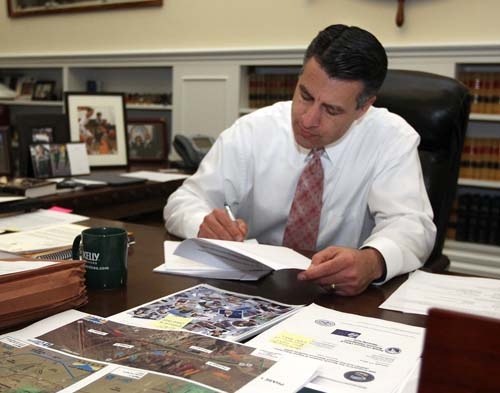State funding increase may not cut Clark County class sizes

Even if the state approves a
$135.8 million increase to education funding sought by Gov. Brian Sandoval, Clark County schools might remain just as crowded, with an average of 35 students per classroom in grades four to 12.
Under Sandoval’s two-part plan, the majority of the money, $88.8 million, would be used to increase the state’s basic funding to districts, which stands at $5,374 per student. That would be bumped to $5,697 by 2015, a 5.9 percent increase.
That probably would equate to
$60 million more for the Clark County School District.
The district could spend that on hiring about 400 teachers, which would reduce the class-size average by one student. But it’s “only a possibility,” district spokeswoman Amanda Fulkerson said.
The district, in contract talks with its four employee groups, isn’t the only party with a say in how additional funds might be spent. Although some district unions in the past have agreed to pay freezes to keep costs down for the cash-strapped school system, there is no guarantee that will continue.
“With the wave of an arbitrator’s pen, that money could go elsewhere,” said Fulkerson, referring to possible pay raises for 17,000 teachers, the district’s largest employee group, a matter that is in arbitration.
If the arbitrator, an objective third party, upholds teacher salary increases, it would cost an extra $50 million, Fulkerson estimated.
It’s happened before.
Last school year, the district sought to freeze teacher salaries to stave off layoffs. But an arbitrator ruled for the Clark County Education Association and forced the nation’s fifth-largest district to pay raises while the unions representing 12,000 administrators, support staff and school police agreed to a pay freeze.
To cover the expense, the district cut 1,000 teaching positions over the summer, increasing class sizes from 32 to 35 students this school year, the highest ratio among the nation’s 20 largest school districts.
Also, the agreed-to pay freezes for the three other employee groups, which saved $10.79 million, end this summer, meaning terms must be renegotiated.
The second part of the governor’s proposal would use about $47 million of the $135.8 million increase to expand all-day kindergarten to more schools and offer more support to students who speak English as a second language, 50,000 of whom reside in Clark County.
Jim Guthrie, Nevada superintendent of public schools, praised the governor’s plan for directing resources to the root of the “biggest problem in Nevada schools, low achievement.”
To get students on track, schools have to start early, Guthrie emphasized. If children can’t read by third grade, research shows the odds are against them being successful in school.
If that’s true, one out of three Nevada third-graders has a tough road ahead because he or she can’t read at grade level, according to 2011-12 state test results.
Sandoval’s plan seeks to have every third-grader reading at grade level, Guthrie said. A $20 million initiative would spread full-day kindergarten to more schools, and $14 million would provide more support for children learning English.
“You can see the concentration on young kids,” said Guthrie, noting the two largest challenges in Nevada: children who start school as non-English speakers and students whose home lives haven’t prepared them for school.
More than half of Nevada’s 440,000 students live in poverty, and Hispanics constitute the largest student demographic at 39 percent compared with
37 percent who are white.
Nevada’s ranking for public education has hit rock bottom, according to the national Kids Count study on children’s well-being released after last school year.
The Silver State ranked 50th in the nation despite improvements in key areas, such as the percentage of fourth-graders reading at grade level and eighth-graders who are proficient in math.
About a third of Nevada elementary schools offer full-day kindergarten while the rest provide half-day kindergarten, Guthrie said. And many of those schools charge tuition for full-day kindergarten.
The additional $20 million would enable one out of every two schools to offer full-day programs by 2015, Sandoval said.
“All-day kindergarten is a critical foundation for a child’s success,” Sandoval said.
Success won’t be apparent for four or five years should gains in student achievement be realized, said Guthrie, praising Sandoval for the 5.8 percent increase to education funding, which critics say is not enough.
“I believe our posture should be thank you,” said Guthrie, noting that education is up for more of a funding increase than any other activity in the state.
“We are a poor state. He dug down deep, and this is what we have.”
Contact reporter Trevon Milliard at tmilliard@review
journal.com or 702-383-0279.